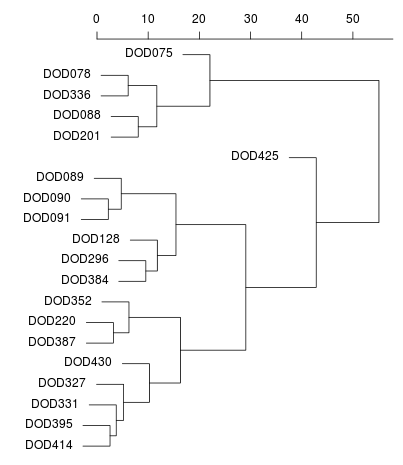I asked Dienekes to include me in his Dodecad Ancestry Project and he gave me the following results:
| Ancestral Component | Percentage |
|---|---|
| South Asian | 44.9% |
| West Asian | 33.7% |
| Southwest Asian | 5.7% |
| North European | 5.5% |
| South European | 3.7% |
| East African | 3.4% |
| Northwest African | 2.1% |
| West African | 0.6% |
| East Asian | 0.4% |
| Northeast Asian | 0.1% |
You can see the results of all the project participants in a spreadsheet. You can also check out the admixture results for the reference samples he used.
Below is a bar chart showing the ancestral population percentages for me (DOD128) along with some other Dodecad participants (those starting with DOD) and some reference populations. I selected those individuals and populations that were somewhat closer to me in their admixture results. Also, as initially sorted, the list goes from most similar to me to least similar from top to bottom.
You can sort the bar chart by the different ancestral components by clicking on the legend on the right.
A word about the ten ancestral components (South Asian, West Asian, Southwest Asian, North European, South European, etc): Admixture results in this case gave 10 ancestral components. These do not necessarily correspond to “pure” ancestral populations and they are not labeled, only defined by their allele frequencies. Dienekes looked at the admixture output for his reference populations and assigned the 10 components different names based on which region it is most common in. Thus calling an ancestral component “West Asian” just means that it is found at highest frequencies in the reference populations living in Western Asia nowadays.
I used hierarchical clustering on the Dodecad results to find out which participants are most similar to me. A tree below shows the section including me.
Closest to me are a Punjabi Brahmin and a half-Sindhi half-Balochi guy, then three Punjabi Jatts.
Through all these investigations, some things have cropped up again and again.
One is that I have a minor amount of African admixture (4% East + West African). Most of it seems to be East African, which is why it doesn’t show up in 23andme ancestry painting. This is consistent with a quarter Egyptian ancestry. An average Egyptian reference sample is 14.7% East African and 4.1% West African. A quarter of that would be 3.7% and 1.0% respectively. Compare that to my 3.4% and 0.6%.
Also, while I am not very similar to Punjabis, they are the group most similar to me. Since there are no Punjabis in the reference data, Sindhis are the next closest. I am in fact more similar to Gujaratis than I am to Turks or any Central or West Asian groups.
